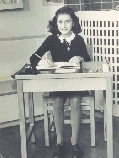World War II: A Tragic Time
Object Pronouns
A pronoun can refer to a noun.
Build Sentences
Look at the noun in the first sentence. Say both sentences. Add the pronoun that refers to, or goes with, the noun.
1. Otto Frank, Anne’s father, had an office. The family hid above it.
1. Otto Frank, Anne’s father, had an office. The family hid above ______.
2. A boy named Peter also hid there. Anne became good friends with ______.
3. One horrible morning, the Nazis found the family. The soldiers took ______ to prison camps.
4. Anne left her diary in the hiding place. A friend found ______.
5. Anne died in the prison camps. After the war, Mr. Frank published her diary. He wanted people to remember ______.
Write a Paragraph 
Work with a partner. Write this paragraph. Add the word him, her, it, or them in each blank. Take turns reading the paragraph aloud.
6. Many people have read it.
You can read Anne’s diary in many languages. Many people have read ___(6)___. Nelson Mandela, a leader in South Africa, said the story encouraged ___(7)___. Several writers have been interested in Anne. They wrote books about ___(8)___. Many people feel Anne’s diary helped ___(9)___ to understand what happened in World War II.
